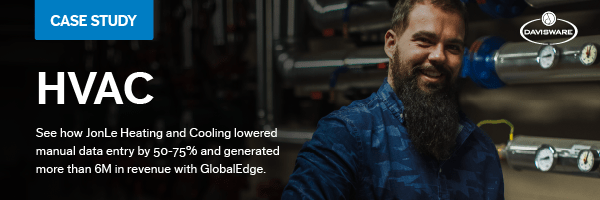As we already find ourselves at the beginning of November, it’s time to discuss what lies ahead, the winter! Along with all the joy the winter brings, it also brings a lot of havoc. Therefore, it is important to educate ourselves on the issues that our industries might come across for this upcoming season. Here at Davisware, we have gathered 5 of the most common HVAC problems your customers may face this winter.
- Frozen Pipes- Pipes can often freeze during colder months. As the temperature begins to decrease, ice begins to accumulate. The ice will then freeze over objects like pipes and coils. This then prevents the water from flowing freely throughout the pipes and prevents the hydroponic systems from functioning properly. When the water stops flowing within the pipes, hot water heaters and steam radiators can easily fail. Sometimes, these pipes can burst because of the significant pressure buildup. The only way to stop the water from the bursting pipe is to turn the water off completely. To fix these issues, try rerouting certain pipes that could be a potential problem or adding an additional layer of insulation to help prevent pipes from freezing.
- Uneven Air Flow & Temperature- Having uneven airflow and temperature is when some rooms in a home or building are much colder than others. A common cause for this is a result of cracks or holes around window sills and doorways. Inspecting vents and ducts for blockages and cleaning out the problem areas can help resolve this issue.

- Dirty Heater Filters- Heater filters remove particles from the air and prevents them from re-entering the room. This is why these filters can often get clogged with dust and dirt when they are overused. As a result of this blockage, the air flow will decrease and along with its ability to keep a room and/or area warm to satisfaction. To fix this issue, make sure the motor and fans are working properly, then clean whatever dust or dirt that is around the filter. Inspect the filter to see if it is bent or discolored. If it is, it needs to be replaced. To ensure your clients’ system run smoothly this winter, advise them to change their filter often (approx. every two to three months).
- Carbon Monoxide Leaks- Perhaps the scariest potential issue of the colder seasons. The heat exchanger should always be inspected every winter as part of annual preventive maintenance. Many of these carbon monoxide leaks occur because of cracked/rusted heaters. It is also nearly impossible to detect because it is odorless and tasteless. To properly evaluate the leak, inspect the heat exchanger for any possible defects. Another important area to check would be the chimney and the top-range vent, which is above the stove. Look for any obstructions that could be the cause of poor ventilation that can block the carbon monoxide gases from exiting the building.
- A Faulty Thermostat or Furnace- Sometimes, the problem lies not in the hardware of the appliance but in the electronics of the thermostat. When fixing a thermostat, sometimes just a calibration will do the trick. If that isn't the case, try repairing any faulty wiring behind it or even replacing the thermostat altogether, then calibrating it to the heater.
To make sure you’re prepared this winter, here are 4 Davisware tips to prevent HVAC issues this winter:
1. Shut down unnecessary cooling equipment and systems
2. Close off main water and drain water piping in unheated spaces around your residential or commercial building
3. Drain cooling towers that will not be in use
4. Inspect your roofs! Specifically look for holes or leaks to apply weather stripping
By educating your customers on these tips and being aware of all the potential risks this winter, you are already well on your way to having a successful winter season with your customers. The winter is hard enough, make sure you’re prepared!
For more useful tips for HVAC professionals and more, subscribe to our blog here!


